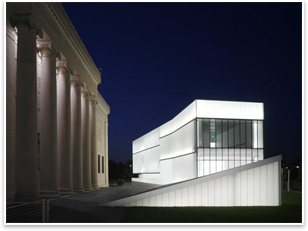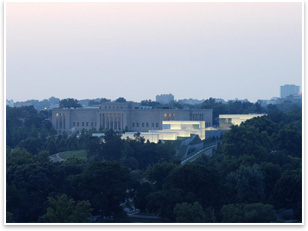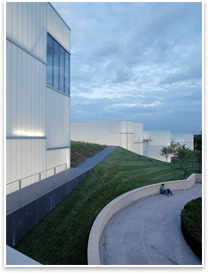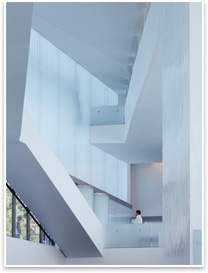Holl’s Luminous Boxes Shine on Kansas City
Goldberger calls Nelson-Atkins addition “one of the best”
by Heather Livingston
Contributing Editor
 Steven Holl’s addition to the Nelson-Atkins Museum of Art in Kansas City, Mo., opened to the public on June 9. Sited among the eastern edge of the museum campus, Holl’s luminescent addition is a visual foil to the original 1933 Beaux-Arts building. Selected through an international juried competition, Steven Holl Architects was awarded the commission for the new building in 1999. The design was chosen for its imagination and unexpected solution to the institution’s needs, balancing innovation with respect for the original building. Steven Holl’s addition to the Nelson-Atkins Museum of Art in Kansas City, Mo., opened to the public on June 9. Sited among the eastern edge of the museum campus, Holl’s luminescent addition is a visual foil to the original 1933 Beaux-Arts building. Selected through an international juried competition, Steven Holl Architects was awarded the commission for the new building in 1999. The design was chosen for its imagination and unexpected solution to the institution’s needs, balancing innovation with respect for the original building.
 Holl said of the design, “The idea of complementary contrast, the Stone and the Feather, drove our design for the addition to the classical stone temple and surrounding landscape. The addition is not an object: we envisioned a new paradigm fusing landscape and architecture. In contrast to the stone building, the new lightweight architecture of glass lenses is scattered about the landscape framing sculpture gardens.” Holl said of the design, “The idea of complementary contrast, the Stone and the Feather, drove our design for the addition to the classical stone temple and surrounding landscape. The addition is not an object: we envisioned a new paradigm fusing landscape and architecture. In contrast to the stone building, the new lightweight architecture of glass lenses is scattered about the landscape framing sculpture gardens.”
The new Bloch Building is the centerpiece of a dramatic transformation of the entire institution that includes major renovations to the original building, a restoration of the Sculpture Park, and a complete reinstallation of the permanent galleries, drawing from the more than 34,500 works in its collection. The new 165,000-square-foot expansion increases museum space by more than 70 percent and features five distinct levels of expansive, light-filled galleries.
 Luminous, undulating interplay Luminous, undulating interplay
Five lenses of glass walls emerge from the ground to create a luminous, undulating interplay among architecture, landscape, and art and a dynamic interaction between inside and outside, translucence and opacity, and tranquility and energy. The lenses’ multiple layers of glass gather, diffuse, and refract light, at times materializing light like blocks of ice. During the day the lenses inject varying qualities of light into the galleries, while at night the sculpture garden glows with their internal light.
The sculpture garden continues up and over the gallery roofs, providing sustainable green roofs to achieve high insulation and control storm water. The meandering path threaded among the lenses in the Sculpture Park has its sinuous complement in the open flow through the continuous level of galleries below. The scheme creates unique spaces for particular works of art, with a court dedicated to the Museum’s significant holdings of Isamu Noguchi sculptures and an entry plaza and reflecting pool designed in collaboration with Walter de Maria. The galleries are organized in sequence to support the progression of the collections and gradually step down into the Sculpture Park.
 As visitors move through the new addition, they will experience a flow along light, art, architecture, and landscape, with punctuated views into the landscape. “The movement of the body as it crosses through overlapping perspectives, through the landscape and the free movement threaded among the light gathering lenses of the new addition are the elemental connections between ourselves and architecture,” says Holl. As visitors move through the new addition, they will experience a flow along light, art, architecture, and landscape, with punctuated views into the landscape. “The movement of the body as it crosses through overlapping perspectives, through the landscape and the free movement threaded among the light gathering lenses of the new addition are the elemental connections between ourselves and architecture,” says Holl.
New Yorker architecture critic Paul Goldberger recently wrote of the Nelson-Atkins addition,” The building is not just Holl’s finest by far, but also one of the best museums of the last generation” (New Yorker, April 30 2007).
|





